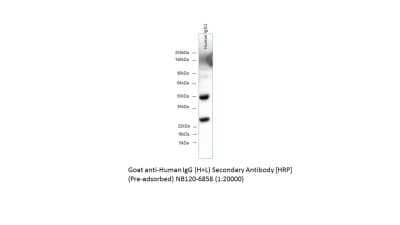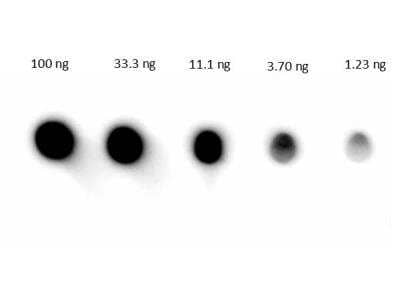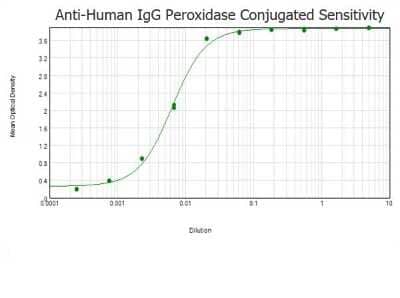Goat anti-Human IgG (H+L) Secondary Antibody [HRP]
Novus Biologicals, part of Bio-Techne | Catalog # NB120-6858


Conjugate
Catalog #
Key Product Details
Species Reactivity
Human
Applications
Dot Blot, ELISA, Immunohistochemistry, Western Blot
Label
HRP
Antibody Source
Polyclonal Goat IgG
Concentration
Please see the vial label for concentration. If unlisted please contact technical services.
Product Specifications
Immunogen
Goat anti-Human IgG (H+L) Secondary Antibody [HRP] was produced by repeated immunization with human IgG whole molecule in goat.
Clonality
Polyclonal
Host
Goat
Isotype
IgG
Description
For extended storage aliquot contents and freeze at -20C or below. Avoid cycles of freezing and thawing. Centrifuge product if not completely clear after standing at room
This product was prepared from monospecific antiserum by immunoaffinity chromatography using Human IgG coupled to agarose beads followed by solid phase adsorption(s) to remove any unwanted reactivities. Assay by immunoelectrophoresis resulted in a single precipitin arc against anti-Peroxidase, anti-Goat Serum, Human IgG and Human Serum.
This product was prepared from monospecific antiserum by immunoaffinity chromatography using Human IgG coupled to agarose beads followed by solid phase adsorption(s) to remove any unwanted reactivities. Assay by immunoelectrophoresis resulted in a single precipitin arc against anti-Peroxidase, anti-Goat Serum, Human IgG and Human Serum.
Scientific Data Images for Goat anti-Human IgG (H+L) Secondary Antibody [HRP]
Western Blot: Goat anti-Human IgG (H+L) Secondary Antibody [HRP] [NB120-6858] - Analysis using recombinant human IgG1 lysate. From a verified customer review.
Dot Blot: Goat anti-Human IgG (H+L) Secondary Antibody [HRP] [NB120-6858] - Lane 1: 100 ng. Lane 2: 33.3 ng. Lane 3: 11.1 ng. Lane 4: 3.7 ng. Lane 5: 1.23 ng. Secondary Antibody: NB120-6858, incubated with blocking buffer for 1 hour at RT.
ELISA: Goat anti-Human IgG (H+L) Secondary Antibody [HRP] [NB120-6858] - ELISA results of purified Goat anti-Human IgG (H+L) Secondary Antibody [HRP] tested against BSA-conjugated peptide of immunizing peptide. Each well was coated in duplicate with 1.0 ug of Human IgG
Applications for Goat anti-Human IgG (H+L) Secondary Antibody [HRP]
Application
Recommended Usage
ELISA
1:20000 - 1:80000
Immunohistochemistry
1:1000 - 1:5000
Western Blot
1:5000 - 1:25000
Application Notes
This product has been tested by dot blot and ELISA and is suitable for immunoblotting (western or dot blot), ELISA, immunoperoxidase electron microscopy and immunohistochemistry as well as other peroxidase-antibody based enzymatic assays requiring lot-to-lot consistency.
NOTE: Do NOT add Sodium Azide (it inhibits HRP irreversibly).
NOTE: Do NOT add Sodium Azide (it inhibits HRP irreversibly).
Reviewed Applications
Read 1 review rated 5 using NB120-6858 in the following applications:
Formulation, Preparation, and Storage
Purification
Multi-step
Formulation
0.02 M Potassium Phosphate, 0.15 M Sodium Chloride, pH 7.2, 10 mg/mL Bovine Serum Albumin (BSA) - Immunoglobulin and Protease free
Preservative
0.01% Gentamicin Sulfate
Concentration
Please see the vial label for concentration. If unlisted please contact technical services.
Shipping
The product is shipped with polar packs. Upon receipt, store it immediately at the temperature recommended below.
Stability & Storage
Store at 4C short term. Aliquot and store at -20C long term. Avoid freeze-thaw cycles.
Background: IgG (H+L)
The 4 IgG subclasses, sharing 95% amino acid identity, include IgG1, IgG2, IgG3, and IgG4 for humans and IgG1, IgG2a, IgG2b, and IgG3 for mice. The relative abundance of each human subclass is 60% for IgG1, 32% for IgG2, 4% for IgG3, and 4% for IgG4. In an IgG deficiency, there may be a shortage of one or more subclasses (4).
References
1. Painter RH. (1998) Encyclopedia of Immunology (Second Edition). Elsevier. 1208-1211
2. Chapter 9 - Antibodies. (2012) Immunology for Pharmacy. Mosby 70-78
3. Schroeder H, Cavacini, L. (2010) Structure and Function of Immunoglobulins. J Allergy Clin Immunol. 125(2 0 2): S41-S52. PMID: 20176268
4. Vidarsson G, Dekkers G, Rispens T. (2014) IgG subclasses and allotypes: from structure to effector functions. Front Immunol. 5:520. PMID: 25368619
Additional IgG (H+L) Products
Product Documents for Goat anti-Human IgG (H+L) Secondary Antibody [HRP]
Product Specific Notices for Goat anti-Human IgG (H+L) Secondary Antibody [HRP]
This product is for research use only and is not approved for use in humans or in clinical diagnosis. Secondary Antibodies are guaranteed for 1 year from date of receipt.
